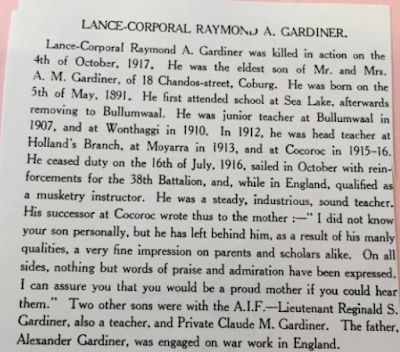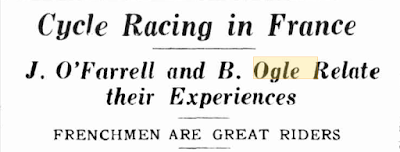In October last year, I featured the Coburg Cycling Club's Honour Board which you can read about here. The Club has now given me access to a much better image, which you see here.
Image courtesy Coburg Cycling Club
Over the next few weeks, I will be featuring some of the stories of the Club members who served in World War One, beginning with the men listed in the Brunswick and Coburg Leader, 4 August 1916.
Among the latest members who have been wounded are L. Cpl. Broome and Pte. Lou. Ambler. Both are progressing favorably, according to latest advice.
Recently we announced that Pte. C. Jones, our great champion, had been 'seriously wounded' receiving a bullet in the head. We are now pleased to report that he has been through a successful operation and is on the road to recovery. He will be remembered as one of our foremost road and track champions, representing the club in Nella Shields and road premierships, gaining 2nd place in the 25-mile premiership, and other races too numerous to mention. His cheerful, willing disposition, his good nature, gained for him many friends in the ranks, as it did in the Coburg Cycling Club. He enlisted in July 1915, in company with J. Sheppard and W. Cooper, who, we are pleased to report, are in the best of health.
Corporal Gambetta, who enlisted and was rejected, was for several months on home service. He has now received his discharge. We will now see his well-known figure on the road. He is training hard in preparation for the big wheel race at the Exhibition, to be held this month. He has every hope of getting into form again and repeating his former successes. His ambition is to get to the front and fight for King and country.
I have written before about Lou (Lew) Ambler and his sister Milanie who served as a nurse. You can read their story here.
I'll be featuring Lance Corporal Broom, Corporal Jones, J. Sheppard and W. Cooper shortly.
Today, though, I'd like to tell you the story of Corporal Gambetta who enlisted and was rejected. His was a difficult life. He never did make it to the Front. Nor did he shine in the cycling world. This is his story.
Truth, 16 October 1921
It took me a while to track down Corporal Gambetta's story. At first I thought he was part of a much better known branch of his extended family whose father Christopher Leon Gambetta of the Education Department staff saw three sons go off to war, but it soon became clear that this was not so. They were related, but several generations back.
I began with the World War One Personal Case Files at the National Archives of Australia where I discovered that Private Louis Charles Gambetta of the 24th Depot enlisted on 13 January 1916 and was discharged on medical grounds on 22 July 1916. He was single, born on 3 May 1895, and worked as a clerk collector (that is, a rent collector) for D.J. Pemberton & Co., Estate Agents of 393 Rathdown Street, Carlton.
A quick look through the World War One service records on the National Archives of Australia website told me that he was never accepted for active service. And at this stage I had no idea why he might have been rejected.
There were very few cycling references to Gambetta in the newspapers: one in April 1915 when he took part in a Coburg Cycling Club 5 mile race at Campbellfield and another in November 1915 when he took part in a Bronzewing Cycling Club Time Trial. So I knew that he wasn't an active member of the Club.
I believe I've found his birth - at Long Gully, parents Louis and Grace Gemmel (McLean) Gambetta. It appears his father died at Bendigo Hospital in 1898 aged only 27 and that his mother remarried the following year to an Andrew Stephenson.
How Louis Gambetta came to be living in Melbourne's northern suburbs is unclear, but in September 1914, 18 year old Louis was living with his uncle Jack Gambetta, a Metropolitan Board of Works employee in Lygon Street, Carlton.
It is unclear what happened to Gambetta during the war years, although we do know that he did not serve in the AIF. He next appears in the public record in November 1920 when he attacked the man whose house he lived in at Cadman Street, West Brunswick, stabbing him a number of times and slashing himself. The newspaper headline 'Lovelorn Youth Runs Amok' greeted readers of the Age on 2 November 1920. Found not guilty on the grounds of insanity he was transferred to the Sunbury Lunatic Asylum.
I found no more references to Gambetta in the Victorian newspapers, but a year after his court appearance in Melbourne, he found himself in the Sydney Central Court charged with fraud and claiming to be a cousin of the General Manager of the Tramway Board in Melbourne. (Not quite the same as an MMBW employee, but I think this must be a reference to Jack Gambetta with whom he lived in 1914.)
Finally, in June 1924 he appeared in Redfern Court charged with breaking and entering and receiving. Sentenced to two years imprisonment, he presented a pathetic figure to the court, a drug addict, claiming to have hip disease, a tubercular leg and a useless left arm (after his failed suicide attempt in 1920). He told the judge that he had 'one leg in the grave' and would have welcomed a death sentence.
This is eight years after Louis Gambetta attempted to join the AIF and was rejected. Reading between the lines, it may be that he always had hip disease, but his rejection by the military and the 1920 incident, suggests that his mental health was fragile, too.
The last public record relating to Louis Charles Gambetta. NSW Police Gazette, Criminal Register, 23 April 1930.
Gambetta survived another 24 years. In 1949 he was living in Redfern, NSW. He died in October 1954 and is buried at Rookwood Cemetery, NSW.
A difficult story, but there must have been many more men like him who could not and did not cope with society's demands, tried to make their way in groups like the Coburg Cycling Club, tried to hold down steady work, enlist like other men, but just couldn't make it work for them.
Louis Gambetta does not appear on the Cycling Club's Honour Board, or on anyone else's Honour Board for that matter. His story has remained hidden for almost a hundred years. Perhaps you think it shouldn't be brought out into the public now, but I felt it was an important story to tell. I fear that too many people still slide through the cracks one hundred years later. And I wonder if our society would deal any better with Louis Gambetta if he were to offend today.
Sources for Gambetta story:
World War One Personal Case Files at the National Archives of Australia
Winner, 7 April 1915, 17 November 1915
Fairfield Infectious Diseases Admissions Register, 9 September 1914
Age, 23 October 1920, 2 November 1920
VPRS 515/P0001/70. Central Register of Prisoners, Public Record Office of Victoria. Prisoner number 35712.
Sydney Sun, 13 October 1921
Truth, 16 October 1921
Sydney Evening News, 11 June 1924
Barrier Miner, 10 July 1924
Brisbane Courier, 11 July 1924
Rookwood General Cemetery Records
1949 electoral rolls
NSW Police Gazette, Criminal Register, 23 April 1930

































